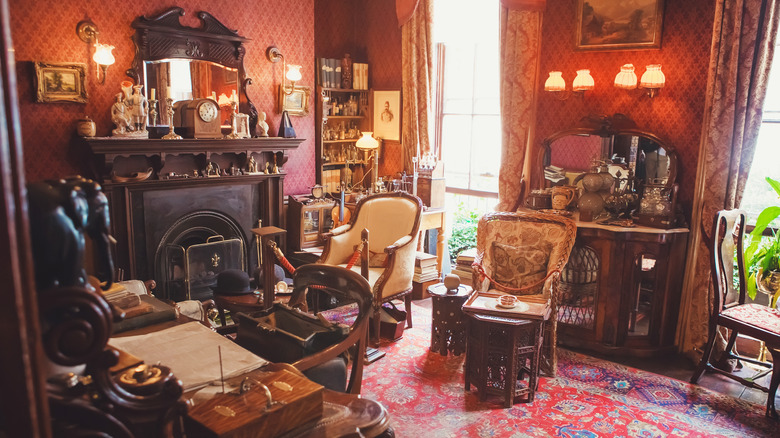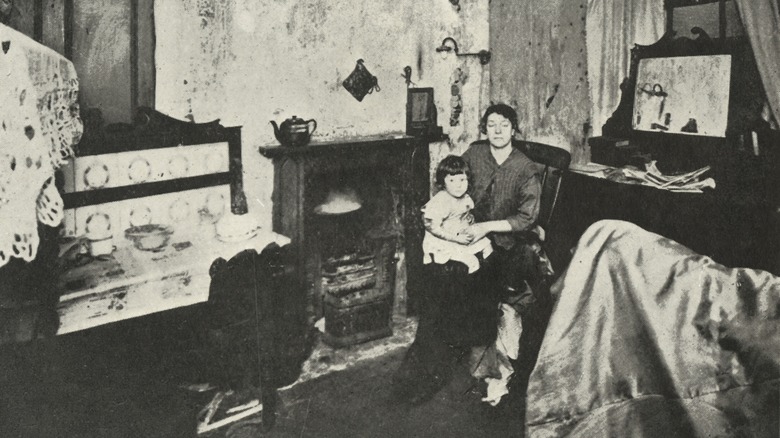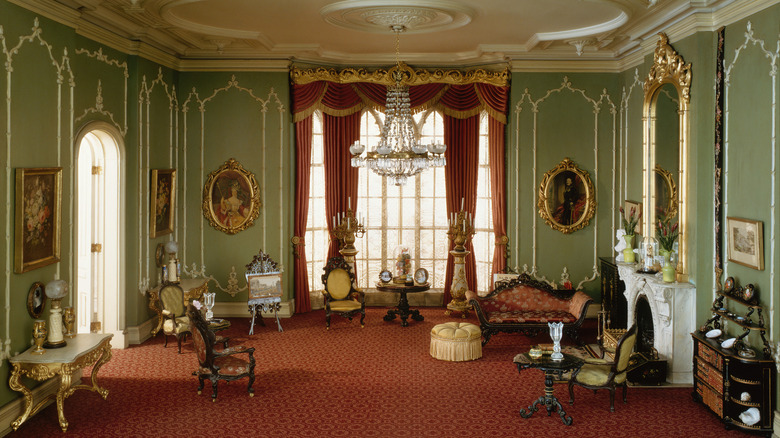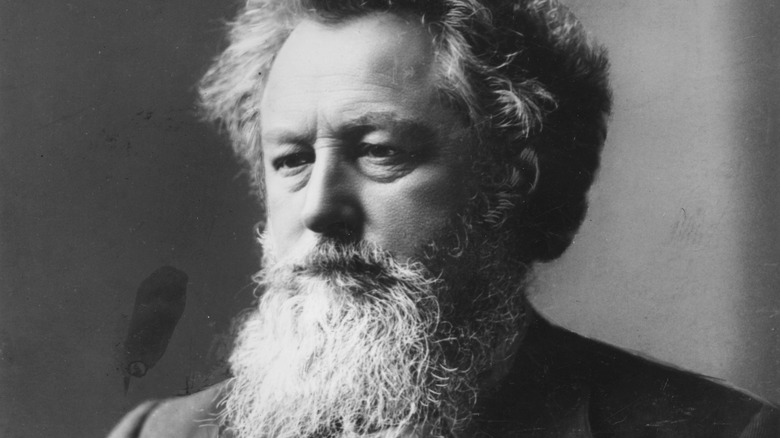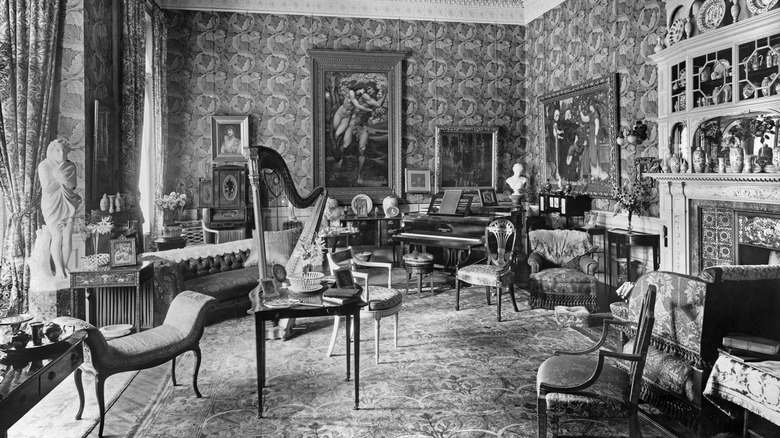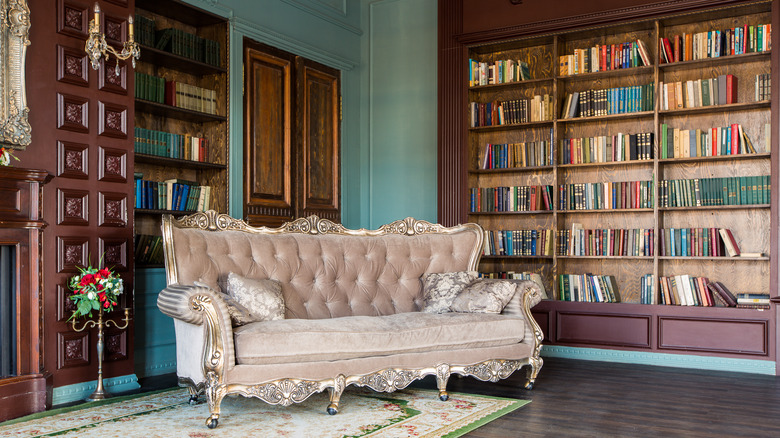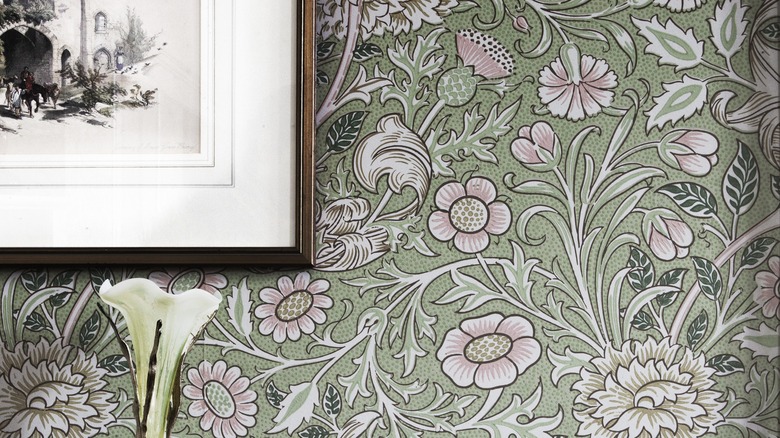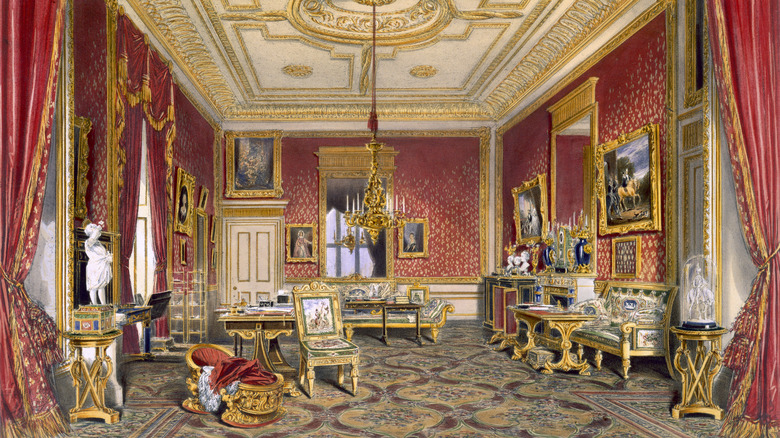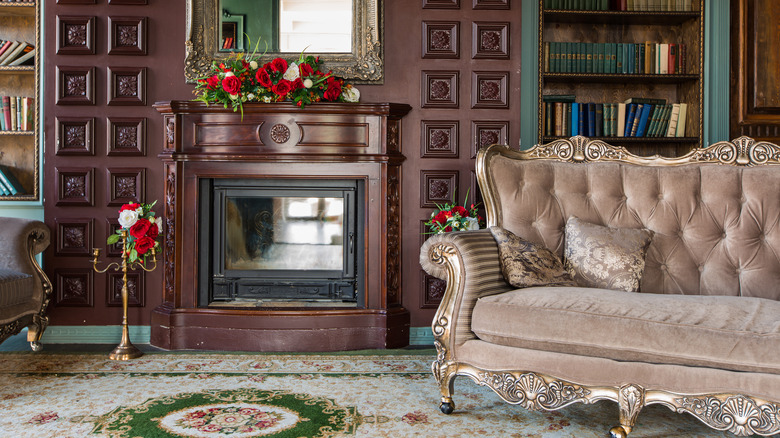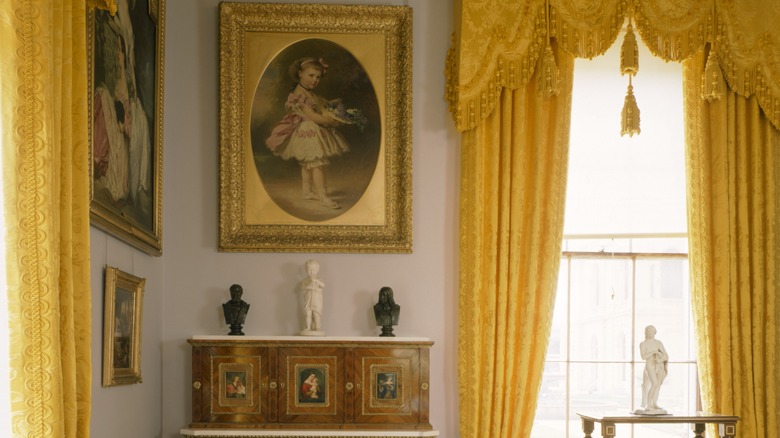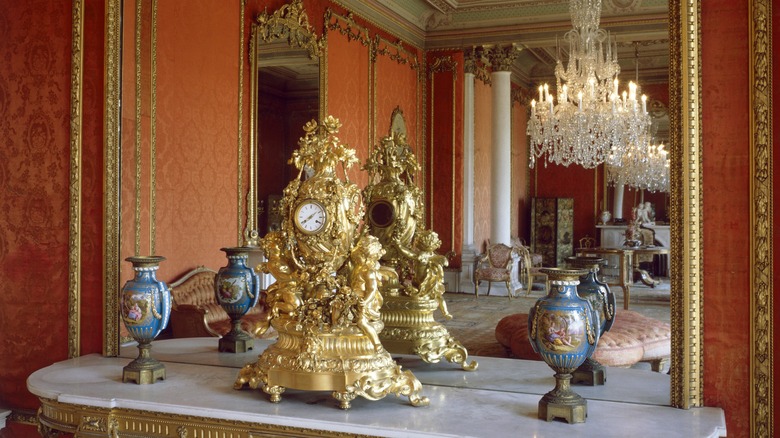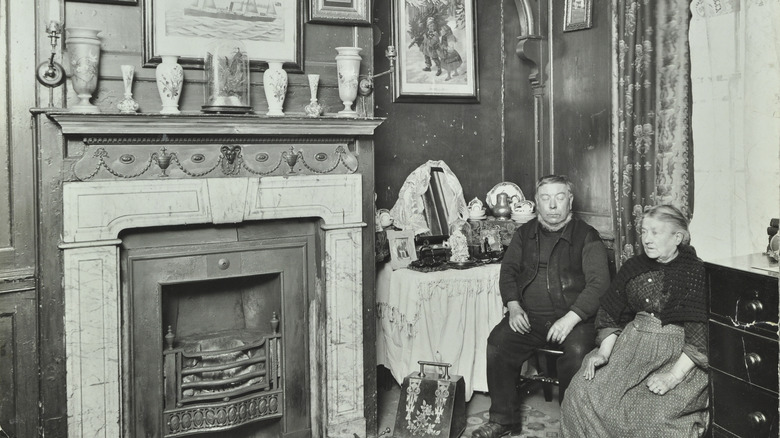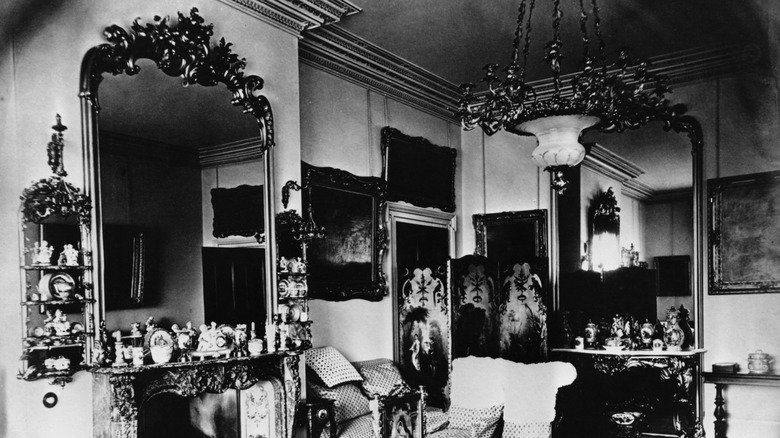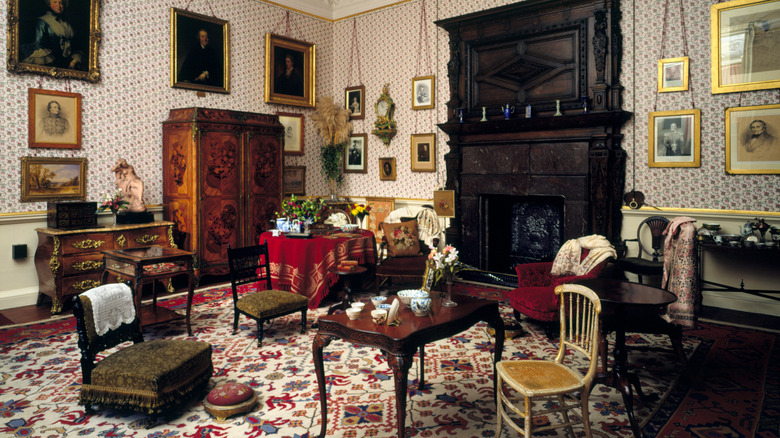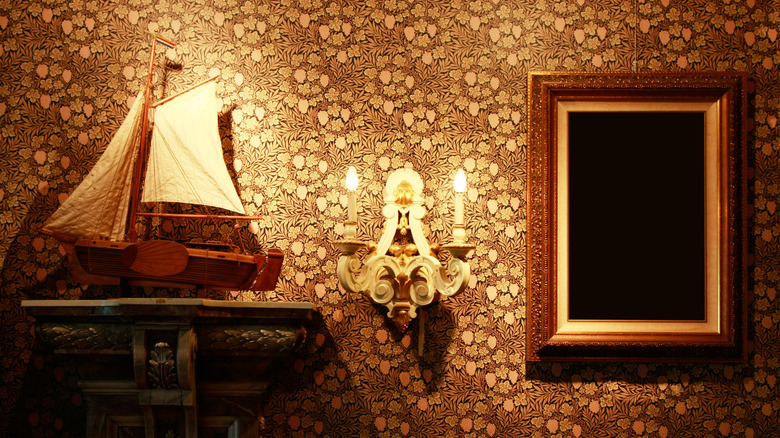The Ultimate Guide To Victorian Decor
The influence of the Victorian era still haunts our modern age like an impeccably-mannered ghost. The forward-thinking people from this time knew how to leave their mark. The ladies and gentlemen who moved and grooved under the reign of the formidable Queen Victoria gave birth to an age of innovation. According to The National Archives, the Victorian era was a defining moment in humanity and one of extreme contrasts.
While this period produced works like "Alice In Wonderland" and "Peter Pan," it also played host to terrible levels of child mortality (via VictoriasPast). While it vibrated with the wit of writers like Oscar Wilde and Charles Dickens, there was widespread disease and the specter of serial killer Jack the Ripper (via History Collection). This paradoxical time saw mass industrialization, poverty, progress, and terrible working conditions. However, the Victorians left the world in better shape than when they arrived. One of the age's most enduring legacies is the unique substance and style found throughout Victorian homes. Let's peel back the fading wallpaper, lift the frayed rugs, and throw some light into the dusty nooks and crannies of the forgotten parlor. Here is the ultimate guide to Victorian style and interior design.
There were strong class divisions in Victorian society
There was a world of difference between run-down slums and the well-appointed townhouses of Victorian London. According to History Collection, Charles Goodwin was so shocked by conditions in the slums that he wrote, "It seemed scarcely possible that human beings could live in them." The paper-thin slums were often hastily erected on unsuitable ground and prone to flooding. Slum lords did not care about living conditions and interior design. Yet even the large families forced to get by in these one-room homes counted themselves lucky. Homelessness was rife during the Victorian era.
Living standards for middle-class and upper-class Victorians were vastly different (via Victorian Children). Their homes were often three stories high and filled with features like marble fireplaces and high ceilings (About Canada). We now look through their eyes to discover how upper-class Victorians decorated their homes and why their style continues to endure.
Victorian decor embraces a maximalist aesthetic
While decluttering is all the rage these days, your inner hoarder might be craving ornate, over-the-top, and lavish Victorian interiors. According to History, the Victorian era produced a mix of styles during the reign of Queen Victoria from 1837 to 1901. However, one unifying factor was the passion for filling all available spaces with eye-catching splendor. Victorians viewed a minimalist home as a crime (via Vinterior). If you were to spend your day lounging idly on silk and gold-trimmed chaise lounge reading "The Picture of Dorian Gray," you needed to surround yourself with things of beauty to cultivate the mind and nurture the soul.
As designer Maiya Kathryn Dacey said, "The Victorian era is symbolic of what was at the time accessible extravagance, where 'more is more is more' must have been the mantra" (via MyDomaine). With the rich getting richer and the rise of the affluent middle-class, there was a desire to turn a home into a museum to showcase an individual's taste, wealth, and experiences. The Victorian living space was a reflection of its inhabitants. It's a form of expression that still strikes a chord. Perhaps this is why many of us choose to go Victorian for our interior design.
Victorian designers pushed the envelope
Victorians working in interior design were known for pushing the envelope and thinking outside the box. According to The Victorian Web, some of the top designers from this time included Owen Jones, William Morris, and Walter Crane. Owen Jones was a notable architect and influential tastemaker who penned "Grammar of Ornament" in 1856 (via National Museums Scotland). The text showcased intricate patterns and designs from different cultural eras and started new trends.
Not to be outdone, William Morris put forth the philosophy, "Have nothing in your houses that you do not know to be useful or believe to be beautiful" (via Victoria and Albert Museum). Morris was the most celebrated designer of the 19th century. He believed in handcrafting everything instead of following the popular industrial notion of "progress." He believed industrial processes produced pieces of poor quality. His heavily detailed and beautiful wallpaper, of which he made over 50 unique designs during his lifetime, were works of art in their own right. These Victorian-style wallpapers arrest your eyes, bewitch your senses, and stand in contemptuous judgment of the plain white walls.
Opulence is optimum
The Victorians weren't just house proud; they were house obsessed. Their attitude was all about going big at home. A well-appointed Victorian home was a statement that the occupant was flourishing in a new age of mass production, opportunity, and trade. If you're thinking of transforming your home into a Victorian showpiece, then remember, both fortune and fashion favor the bold. Victorian chic is not for the faint-hearted. It's big and beautiful. When it comes to kitting your house in the style of Oscar Wilde, there are never too many colors or patterns. The only question should be, "How can I go bigger, better, and bolder on my budget?"
Throw caution to the wind and set sail into a brave new world governed only by the limitations of your imagination. That's how the Victorians rocked and rolled. As interior designer Jamie Green told The Daily Mail, "The Victorians developed tastes for the exotic and the unusual in their homes as a by-product of their fast-expanding views of the world through trade and industry. Displaying finds from far-flung corners of the world, minimalism was never a consideration."
Be bold with your colors
Like Van Gogh, but without the talent, your average Victorian was fascinated by color. According to Love To Know, Victorian living spaces featured a vibrant color palette. While the exteriors of Victorian homes had natural and muted hues such as beige, brown, ochre, russet, taupe, and ecru, the interiors were an altogether different story. These top-hatted men and corset-wearing ladies were bold in their interiors before technicolor was even a thing. If a white wall dares to show its face in any Victorian-themed home, fill it with color, patterns, or perhaps a watercolor by J.M.W. Turner (via Sotheby's). However, exercise some restraint before getting carried away with your paintbrush.
Since Victorians love contrast, they painted their walls rich shades of red, emerald, and dark brown. They saw clashing colors as a dramatic form of artwork. For a modern Victorian vibe, lighten your color palette but keep it vibrant and remember variety is the spice of life. Dark wooden floors and furniture will pair nicely with your bright and bold walls, but it's always nice to spruce up the occasional cabinet with some rainbow-inspired hues. Give your old copy of "Sgt. Pepper" a spin and get busy decorating.
The patterns of Victorian life
From the floors to the walls, the Victorians loved patterns. It's a style that can only be described as a kaleidoscope, transforming the dullest home into a place of color and intrigue. While Victorians were known for their stiff upper lips and reserve, they cut loose with their patterns. The plaids, stripes, damask, and florals popular during this period are still a hit over a century later. The big break for Victorian interior designers came with the invention of aniline dyes. According to Ron Nathan Interiors, the muted and earthy shades of vegetable-based dyeing techniques had previously set the pace. When partnered with the new weaving and printing processes, the bold colors created by aniline dye proved revolutionary. The splash, dash, and panache of colorful patterns transformed the Victorian home.
You can create a Victorian-inspired vibe in your dwelling with some tried and trusted pattern techniques. Get into the swing of things with some old-school and heavily detailed Victorian wallpaper. Nothing says classical taste like a vine, floral, and leaf pattern. Alternately, push the boat out and go for a geometric tiled floor with a lovely little border. A cheap but visibly effective method is to roll out the glamor and let a big old Victorian rug be the focal point of your living room.
Liven up your parlor
The parlor was the show-stealing centerpiece of a Victorian home. It was the stage and set where Victorian hosts cemented their position in society. According to About Canada, the Victorian parlor personified the host, and there was nothing subtle about it. Think lavishly painted walls, patterned wallpaper, and a wealth of clutter fighting for shelf and table space. There was usually a ramshackle collection of paintings, portraits, and ornaments from all over the globe. Think how easy it would be to transform your IKEA-themed living room into an abode fit for the Bridgerton family.
The Victorian parlor came to life on Sundays for family gatherings. Apart from weddings, births, and deaths, the parlor, like a fancy dress, was left empty for most of the year. Parlor pride was a big thing for the Victorian, and there was a certain etiquette to how one should behave in this "special room." These spaces required an abundance of chairs to seat every guest comfortably. It was considered the height of rudeness for a gentleman not to offer up his seat for a lady (via Reader's Digest). Don't skimp on the seating arrangements if you want to liven up your parlor with Victorian style.
Send a message with statement furniture
Victorian furniture was of high quality. While most of it was brown, wooden, and extremely gothic, it had a certain je ne sais quoi. From imposing dressers to elegant chaise lounges, the furniture from this era, like a well-groomed dandy, was made to be admired. According to Regent Antiques, Victorian furniture has an aura of artisan quality and craftsmanship that shines like a beacon in a world of factory-made and mass-produced fodder. Pieces were hand-crafted in an era that never knew the terrible indignity of flat-packs or DIY. The thought of a self-assembled chair or bed would be enough to make a Victorian chap's mustache quiver in a thunderous rage.
If you're thinking of filling your home with Victorian statement furniture, be warned that it may be somber and formal in appearance. These pieces draw influence from an eclectic range of styles but often share common themes. Mahogany, rosewood, and walnut were the preferred woods of choice for the Victorians to shape, stain, and carve their intricate designs. Chairs had lots of patterned upholstery and were usually horseshoe-shaped. The Victorians loved frills and anything with tassels. Inlaid panels and animal motifs were also popular, as were elaborate shaped drawer pulls in the shapes of mushrooms, leaves, fruit, or for the truly adventurous, gargoyles. If you want to make a statement, go for some well-built Victorian furniture.
Dress your windows like a supermodel
Wealthy Victorian homes blocked out social concerns with large curtains. Due to the inescapable filth of the industrial revolution, some naysayers branded big curtains as dirt traps for the smoke and pollution that defined the age. Fortunately, the Victorians favored fashion over function and continued to dress their windows like supermodels.
While heavy-duty drapery kept out the chill, their sheer opulence made them a hit. According to Homestyle, to get that Victorian vibe in your living room, think of your curtainless window as the base of a sponge cake without the cream, jam, and other assorted toppings. You might begin with some under curtain made from white muslin, silk, or lace, add a contrasting border, and then add some flowing velvet or silk that puddles on the floor like a hot mess. French rods, valances, and cornices are optional, but no self-respecting Victorian would go without them. If you want to keep it authentic, replace the under curtain with a canvas blind. Look for one with a natural scene and trimmed fringe.
Go bold with gold accents and chandeliers
There's no point going Victorian if you're not planning to be a little bold. Embrace your inner Vegas, live a little, and get gold accents, brass fixtures, and lavish chandeliers. The Victorians loved their bling and over-the-top ornamentation. According to Wales Online, the beauty of Victorian style is you don't need to do much to capture that elusive 19th-century ambiance in your interiors. It just takes some love and a few select purchases. For example, a chandelier made of brass or gold and crystal will tell the world you have a classical taste, as will a few assorted paintings with gold-gilded frames. A Belfast sink in the kitchen finished with some brass taps is always a conversation starter, as is an old-fashioned and gold-plated telephone.
If you want to get the Victorian look while keeping the overall theme of your home contemporary, consider purchasing a statement piece such as a freestanding style bath with claw feet. If you want to keep it authentic, go for copper or cast iron, polish it to a high sheen, and fill it with buckets of warm water until it reaches the perfect temperature. However, that is just a suggestion.
A well-appointed mantelpiece is just the ticket
There might not have been TVs, smartphones, or what the elders refer to as the wireless in the Victorian age, but they did have parlor games, Oscar Wilde, and fireplaces. The fireplace wasn't just a means of heating the house. It was a focal point where ladies and gentlemen could gather and discuss the news. If you want a Victorian-themed home, pay close attention to your mantel. According to Wisegeek, genuine Victorian mantels are extremely rare and expensive. However, there is a solution called modern reproduction.
Victorian mantelpieces featured oak or marble, but today's reproductions usually come in the form of cast iron. Since open fires can be an environmental hazard, the modern mantel will sit nicely upon gas or electric fireplaces just as well as a real one. The Victorians viewed the mantel as a place to showcase rare and valuable trinkets, such as the original handwritten copy of John Keats' "Ode to a Nightingale" or Thomas De Quincey's first bottle of opium. The chances of us owning such treasures are rare, but we do have the power of online shopping on our side. Fill your mantel with curiosities from far-flung and exotic places to spark conversation with your guests.
Mirror, mirror on the wall
The Victorians were a vain bunch, but they also had standards. No self-respecting chap would neglect to oil his mustache, while no woman would forget to plait her hair. Nevertheless, the idea of lounging about in sweat pants or pajamas would feel wrong to any self–respecting Victorian lady or gentleman. This vanity is why vast and ornamental mirrors were popular. A big, old Victorian mirror in your life might inspire you to get the Victorian look.
According to Westland London, the typical Victorian mirror was grand, elaborate, and striking. They featured a combination of styles from times past, and contrary to popular opinion, they weren't all glitz and glamour. Materials included rosewood or mahogany. A Victorian mirror might be the tonic to help you stay ahead of the curve and on-trend. Give your reflection the ornamentation it deserves, and get a Victorian mirror decorated with cherubs, gargoyles, nymphs, flowers, and maybe a deer or two.
Bring on the clutter
Nothing was too tacky or tasteless for the Victorian with money and time on their hands. There were just extravagant statements and high society to impress. A well-placed suit of armor or sword can be an extremely subtle focal point in a Victorian-style home. If that's not in your budget, everything from vases, throws, cushions, and absinthe bottles can create a Victorian ambiance. Stuffed animals, old pianos, and oil paintings of yourself stroking a cat are also must-haves. For a well-bred Victorian, a bare room was something too ghastly for words.
Walls cluttered with pictures are an extremely Victorian sight, as are clocks, candelabras and sticks, display cases, and natural curiosities. According to The Victorian Emporium, the Victorian home featured natural curiosities, glass ornaments, and elaborate pieces. For example, you might find items like a leather glove on a stand, fossils in a glass box, an iridescent butterfly, volcano rocks, a bottle of sand from the Galapagos Islands, and a vampire cape in a home. Many of these items will be out of reach for the modern consumer. However, you can use your imagination to fill your Victorian-themed home with unique pieces.
Set the mood with an oil or paraffin lamp
In the digital era, we may be able to journey to new realms and faraway lands at the touch of a button or Netflix subscription. However, all the streaming and optic fiber wonder often pale to the old world magic cast by the flicker of an oil lamp. No Victorian home is complete without one. There is a forgotten wonder in living in the pale and holy glow of a candle, oil, or paraffin lamp.
According to Building Conservation, traditional light fittings powered by gas or electricity were around by the end of Queen Victoria's reign. However, for a large part of the era, portable light sources were the only means of illumination. Oil came first, followed by paraffin. In keeping with the period, lamp design involved both function and aesthetics. The beauty of using dim and traditional lighting is you can mute the stark contours of modern interiors and travel back in time to a place of magic and mystery. The wonder and beauty that inspired the Victorians are still all around us, but sometimes it's best to seek it in the shadows.
